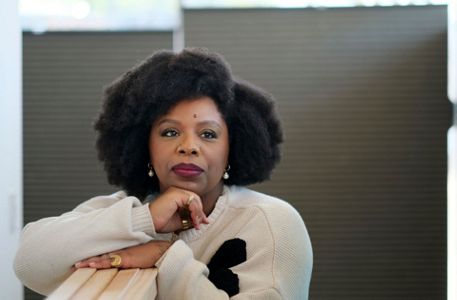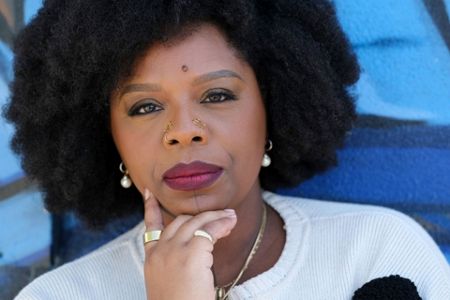LOS ANGELES (AP) — Patrisse Cullors was sitting at a table outside the Crenshaw Dairy Mart, the art collective she co-founded in Inglewood, California, taking advantage of a rare break in the March rains when her phone buzzed with a text message a few weeks ago.
Cullors broke into a contented grin: One of her art pieces had just sold. The work, a tapestry made of vintage mudcloth from Mali and adorned with cowrie shells, is part of her current show at the Charlie James Gallery in Chinatown, an exhibit honoring traditions of the Ifa religion of the Yoruba in West Africa.
A few nights earlier, the longtime artist and activist best known for co-founding Black Lives Matter had experienced another satisfying artistic moment: a solo performance at the Broad museum in which she unfurled a 360-foot-long (110-meter-long) bonnet — meant as a symbol of protection for Black women, among other things — in a show about healing amid hate.
Cullors is leaning into her art these days, gaining sustenance and perspective from it. She speaks of it as not just a vocation, but a means of salvation: At one point, the impact of accusations of financial mismanagement at BLM — from which she resigned in 2021 — wounded her so deeply, her mental health was imperiled and she felt her very life was in danger, she says. What has ultimately saved her more than once, she feels, is her art.
“So much of the last few years has been, to be really honest, just deep depression and anxiety and a lot of trauma, a lot of freezing, a lot of fear,” she says, “and I just kept going back to my art practice. I kept going back to art, and every time I would go back to art, I would feel like myself again. I would feel more connected again and I would feel more hopeful."
“My art practice has saved my life, over and over again," she adds.
In 2019, after nearly seven years in the public spotlight as co-founder of BLM, Cullors contemplated quietly transitioning from day-to-day leadership of BLM Global Network Foundation, Inc. But in 2020, after the murder of George Floyd and a tidal wave of donations to BLM’s foundation amid historic racial justice protests nationwide, Cullors became the organization’s full-time executive director. She said she intended to help build out the foundation’s infrastructure so it could manage the surge in resources.
After the organization revealed it had taken in close to $90 million from donors through early 2021, Cullors and the foundation were targets of sharp criticism from the left and right and from both inside and outside the broader movement. Far-right critics published reports of Cullors’ purchase of a Southern California home and many on the left pushed unproven allegations that she misused donated funds. The controversy eventually quieted, but not before Cullors hired security out of concern for her personal safety. She resigned from the foundation in May 2021.
Then in 2022, criticism of Cullors and BLM intensified again, after the foundation confirmed in nonprofit tax filings that it spent $6 million on a Los Angeles-area compound that includes a home with six bedrooms and bathrooms, a swimming pool, a soundstage and office space. The foundation has said the property is used as a campus for a Black artists fellowship, but Cullors also acknowledged using the home for personal reasons on two occasions.
As the controversy faded last year, Cullors focused on her art practice. At the start of 2023, tragedy struck Cullors’s family — her 31-year-old cousin Keenan Anderson, a father of 5-year-old boy and English teacher at high school in Washington, D.C., died after being zapped by a stun gun during an encounter with Los Angeles traffic police. Cullors joined with family members and local activists in calls for police reforms.
And she turned to art, in a sense, to express her grief — at the influential Frieze Los Angeles art fair, she held a “performance disruption” in February along with fellow activist JaQuel Knight, a peaceful protest to bring attention to deaths of Black people at traffic stops.
The year so far has been a busy one, for the artist, activist and author who also has a multi-year TV development deal with Warner Bros. and is working on a show about the impact of local politics on women.
Her recent show at the Broad, her second at the contemporary art museum, was part of an evening focusing on the effects of colonialism on literature, language, and music of people of color. It reflected her experience with what she describes as “the impact of right-wing media on Black people and Black leaders through targeted misinformation and disinformation campaigns,” and focused on healing.
The performance, titled “Don’t Disappear Us/Keep us Leaping/Low Riders and Bonnets that Heal,” centered on a few seemingly mundane artifacts: the bonnet, which she says has a protective symbolism for Black women; a partially built lowrider; and a trampoline. The piece included a live singer and a recording of Cullors chanting in her daily Ifa religious practice.
Religion will also be a theme of a multi-artist exhibit beginning in October at the Fowler Museum at UCLA, highlighting Yoruba art and featuring works from Nigeria, Brazil, Cuba, and the United States. Cullors will contribute “Free Us,” an installation accompanied by an audio track of prayers, along with several mixed media works and a one-time live performance on Oct. 28.
And Cullors' religious practice is the theme of her current gallery show in Chinatown, “Freedom Portals,” a collaboration with fellow LA-based artist noé olivas — whom she met during graduate school art studies at the University of Southern California — that has been extended to April 15. Highlighting Ifa, it comprises 12 tapestries, illustrations of “Odù,” or oral literary books containing poetic teachings. Eventually, she wants to create 256 such tapestries, accounting for all Odù poetic tutorials.
Walking a guest through the gallery, she explains the simple materials — vintage mudcloth from Mali, black yarn, and cowrie shells — some cast in glittery gold — which are symbolic in the religion and also an element of decoration in crowns and garments.
“This work is really an ode to the Ifa tradition and to the ancient symbology," Cullors says. She explains how the mudcloth was passed on by a friend: “It’s important for me to not be a part of the world of waste, so vintage mudcloth is critical in building out these works.” As for the yarn, that was lying around her house.
The objects are meant to honor tradition but also to be viewed “in response to the contemporary moment and its accelerated pace and attendant exhaustion,” the gallery materials say, referring to community building and self-care.
And self-care is something Cullors is focusing on these days, especially through her art.
“I have spent the better half of my own life fighting on behalf of others,” she says. “But in the last couple of years it has taken a lot to figure out how to fight for myself, and to fight for my mental health, spiritual health and emotional health."
“These artworks are a really deeply personal call to fight for myself, especially as a Black woman,” she adds. "Because many people don’t fight for us.”
___
AP National Writer Aaron Morrison contributed to this report from New York.
Copyright 2023 The Associated Press. All rights reserved. This material may not be published, broadcast, rewritten or redistributed without permission.














